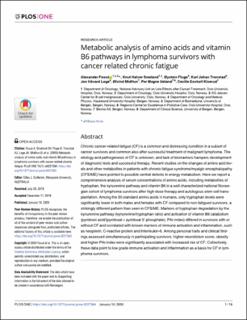| dc.contributor.author | Fosså, Alexander | |
| dc.contributor.author | Smeland, Knut Bjøro | |
| dc.contributor.author | Fluge, Øystein | |
| dc.contributor.author | Tronstad, Karl Johan | |
| dc.contributor.author | Loge, Jon Håvard | |
| dc.contributor.author | Midtun, Øyvind | |
| dc.contributor.author | Ueland, Per Magne | |
| dc.contributor.author | Kiserud, Cecilie E. | |
| dc.date.accessioned | 2021-05-14T10:45:53Z | |
| dc.date.available | 2021-05-14T10:45:53Z | |
| dc.date.created | 2020-09-22T11:47:18Z | |
| dc.date.issued | 2020 | |
| dc.identifier.issn | 1932-6203 | |
| dc.identifier.uri | https://hdl.handle.net/11250/2755276 | |
| dc.description.abstract | Chronic cancer-related fatigue (CF) is a common and distressing condition in a subset of cancer survivors and common also after successful treatment of malignant lymphoma. The etiology and pathogenesis of CF is unknown, and lack of biomarkers hampers development of diagnostic tests and successful therapy. Recent studies on the changes of amino acid levels and other metabolites in patients with chronic fatigue syndrome/myalgic encephalopathy (CFS/ME) have pointed to possible central defects in energy metabolism. Here we report a comprehensive analysis of serum concentrations of amino acids, including metabolites of tryptophan, the kynurenine pathway and vitamin B6 in a well characterized national Norwegian cohort of lymphoma survivors after high-dose therapy and autologous stem cell transplantation. Among the 20 standard amino acids in humans, only tryptophan levels were significantly lower in both males and females with CF compared to non-fatigued survivors, a strikingly different pattern than seen in CFS/ME. Markers of tryptophan degradation by the kynurenine pathway (kynurenine/tryptophan ratio) and activation of vitamin B6 catabolism (pyridoxic acid/(pyridoxal + pyridoxal 5'-phosphate), PAr index) differed in survivors with or without CF and correlated with known markers of immune activation and inflammation, such as neopterin, C-reactive protein and Interleukin-6. Among personal traits and clinical findings assessed simultaneously in participating survivors, higher neuroticism score, obesity and higher PAr index were significantly associated with increased risk of CF. Collectively, these data point to low grade immune activation and inflammation as a basis for CF in lymphoma survivors. | en_US |
| dc.language.iso | eng | en_US |
| dc.publisher | PLoS | en_US |
| dc.rights | Navngivelse 4.0 Internasjonal | * |
| dc.rights.uri | http://creativecommons.org/licenses/by/4.0/deed.no | * |
| dc.title | Metabolic analysis of amino acids and vitamin B6 pathways in lymphoma survivors with cancer related chronic fatigue | en_US |
| dc.type | Journal article | en_US |
| dc.type | Peer reviewed | en_US |
| dc.description.version | publishedVersion | en_US |
| dc.rights.holder | Copyright the authors. | en_US |
| dc.source.articlenumber | e0227384 | en_US |
| cristin.ispublished | true | |
| cristin.fulltext | original | |
| cristin.qualitycode | 1 | |
| dc.identifier.doi | 10.1371/journal.pone.0227384 | |
| dc.identifier.cristin | 1832040 | |
| dc.source.journal | PLOS ONE | en_US |
| dc.relation.project | Norges forskningsråd: 272680 | en_US |
| dc.identifier.citation | PLoS ONE. 2020, 15 (1), e0227384. | en_US |
| dc.source.volume | 15 | en_US |
| dc.source.issue | 1 | en_US |

